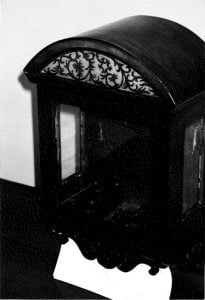
A conversation with Simon Macintyre, a specialist tutor in fine furniture restoration who runs his own restoration business in West Sussex in England.
Simon Macintyre is one of the visiting external tutors at the Chippendale International School of Furniture. He teaches the skilled techniques involved in fine furniture restoration for a week in the first term and a second week in the third term.
“Learning about furniture restoration allows the students to relive the experience of furniture making over the last 400 years”, Simon says. “The furniture students learn the principles of good furniture construction and are shown how, unfortunately, style can sometimes triumph over function.
“I love teaching the students here. We all worked on restoring a large round table from the Scottish National Portrait Gallery in Edinburgh: this involved various veneer and carcass repairs and laying a large leather top. It’s a steep learning curve but most students rise spectacularly to the challenges and grow demonstrably during the furniture restoration course.
“We’ve also restored chests of drawers, card tables, long case clocks, bureaux and dining room chairs (which tend to take a lot of daily punishment!). The students can be quite reserved initially but they really get into it by the end of the furniture restoration course.”

Simon thinks that the “Furniture School works very well. The furniture course has an extremely well structured programme. The students know what to expect each week, and the pastoral care is also good; the students get help with finding accommodation, and Izzy helps them integrate with the local community, encouraging them to go to ceilidhs and other events.”
Simon trained with Anselm Fraser, the furniture school Principal, in 1981-82. His workshop is in the Norfolk Estate’s village joiner’s shop in Arundel. The Duke of Norfolk leads one of England’s best known Catholic dynasties with a lineage going all the way back to 1066 and the Norman Conquest.
Simon works on private furniture restoration commissions as well as for the antique trade. His famous clients have included: rock musician Brian Ferry; the sculptor Philip Jackson, well known for creating seven big bronze bomber crew statues for St James’s Park in London; the Benson family, founders of Kleinwort Benson fame; and the Bonham Carters, who number Hollywood star Helen Bonham Carter.
The furniture restorer’s projects are mostly 17th, 18th and 19th century English furniture, including Chippendale Furniture, although they have also spanned rare Elizabethan and Jacobean furniture. He particularly likes Queen Anne furniture and the simplicity of early Georgian pieces, which he describes as “quintessential English furniture”.
Simon says that “the quality of the materials used for making furniture has fallen steadily over the centuries. Wood which is currently commercially available, might still have the same name, as with ‘mahogany’ for example, but that’s where the similarity ends. I have to source 30 different species of tropical hard woods and veneers, many of which are now protected and commercially unavailable, so have to be continually on the look out for rare hardwoods; I recently managed to track down a trunk of 100 year old rosewood in a garage in the Channel Islands.
“The furniture restoration techniques I use have to be a lot less mechanised than at the school. Most of the restoration work has to be done with high quality hand tools made of decent steel with sharp edges. Modern tools are often sub-standard.
“I work with the original style of the piece and try to get inside the craftsman’s head. Projects often involve repairing damaged veneers and renewing old polish finishes.
“I once restored a case for a bracket clock made by England’s foremost clockmaker, Thomas Tompian, worth a quarter of a million pounds. Another interesting piece was a Guernsey tea table which had been wrecked by occupying German troops during the Second World War.”

Returning to his furniture restoration courses at the school, Simon Macintyre says:
“I teach the furniture school students the correct restoration procedures. To avoid devaluing a piece of antique furniture, they need to understand it before starting work. Undoing the poor restoration work done by others is the bane of a furniture restorer’s life; you can find nails or screws in loose joints that have caused a lot of damage, and other poor quality repairs.
“The students learn how to be exacting with their estimates and about the importance of developing good client relationships. They have to learn to consult and talk through issues that emerge. I teach them not to lower their commission prices too much so they can afford to do a good job without cutting corners.
“I give talks on the different furniture styles and features for particular periods. The students get a good grounding of knowledge and go on to learn by experience.
“Many of the students keep in touch with me after I’ve headed back south.”
Simon Macintyre can be contacted at macintyre641@aol.com or on 01903 883387.